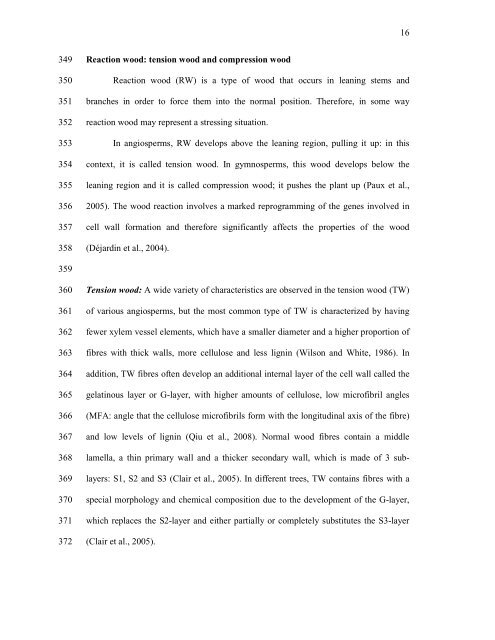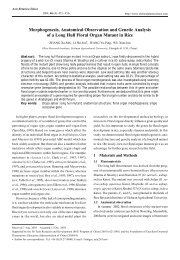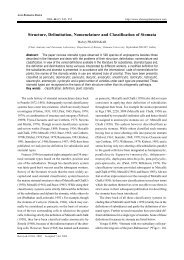Abiotic and biotic stresses and changes in the lignin ... - ResearchGate
Abiotic and biotic stresses and changes in the lignin ... - ResearchGate
Abiotic and biotic stresses and changes in the lignin ... - ResearchGate
You also want an ePaper? Increase the reach of your titles
YUMPU automatically turns print PDFs into web optimized ePapers that Google loves.
16<br />
349<br />
350<br />
351<br />
352<br />
353<br />
354<br />
355<br />
356<br />
357<br />
358<br />
Reaction wood: tension wood <strong>and</strong> compression wood<br />
Reaction wood (RW) is a type of wood that occurs <strong>in</strong> lean<strong>in</strong>g stems <strong>and</strong><br />
branches <strong>in</strong> order to force <strong>the</strong>m <strong>in</strong>to <strong>the</strong> normal position. Therefore, <strong>in</strong> some way<br />
reaction wood may represent a stress<strong>in</strong>g situation.<br />
In angiosperms, RW develops above <strong>the</strong> lean<strong>in</strong>g region, pull<strong>in</strong>g it up: <strong>in</strong> this<br />
context, it is called tension wood. In gymnosperms, this wood develops below <strong>the</strong><br />
lean<strong>in</strong>g region <strong>and</strong> it is called compression wood; it pushes <strong>the</strong> plant up (Paux et al.,<br />
2005). The wood reaction <strong>in</strong>volves a marked reprogramm<strong>in</strong>g of <strong>the</strong> genes <strong>in</strong>volved <strong>in</strong><br />
cell wall formation <strong>and</strong> <strong>the</strong>refore significantly affects <strong>the</strong> properties of <strong>the</strong> wood<br />
(Déjard<strong>in</strong> et al., 2004).<br />
359<br />
360<br />
361<br />
362<br />
363<br />
364<br />
365<br />
366<br />
367<br />
368<br />
369<br />
370<br />
371<br />
372<br />
Tension wood: A wide variety of characteristics are observed <strong>in</strong> <strong>the</strong> tension wood (TW)<br />
of various angiosperms, but <strong>the</strong> most common type of TW is characterized by hav<strong>in</strong>g<br />
fewer xylem vessel elements, which have a smaller diameter <strong>and</strong> a higher proportion of<br />
fibres with thick walls, more cellulose <strong>and</strong> less lign<strong>in</strong> (Wilson <strong>and</strong> White, 1986). In<br />
addition, TW fibres often develop an additional <strong>in</strong>ternal layer of <strong>the</strong> cell wall called <strong>the</strong><br />
gelat<strong>in</strong>ous layer or G-layer, with higher amounts of cellulose, low microfibril angles<br />
(MFA: angle that <strong>the</strong> cellulose microfibrils form with <strong>the</strong> longitud<strong>in</strong>al axis of <strong>the</strong> fibre)<br />
<strong>and</strong> low levels of lign<strong>in</strong> (Qiu et al., 2008). Normal wood fibres conta<strong>in</strong> a middle<br />
lamella, a th<strong>in</strong> primary wall <strong>and</strong> a thicker secondary wall, which is made of 3 sublayers:<br />
S1, S2 <strong>and</strong> S3 (Clair et al., 2005). In different trees, TW conta<strong>in</strong>s fibres with a<br />
special morphology <strong>and</strong> chemical composition due to <strong>the</strong> development of <strong>the</strong> G-layer,<br />
which replaces <strong>the</strong> S2-layer <strong>and</strong> ei<strong>the</strong>r partially or completely substitutes <strong>the</strong> S3-layer<br />
(Clair et al., 2005).







